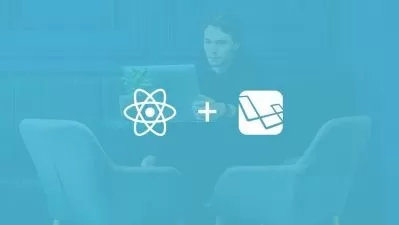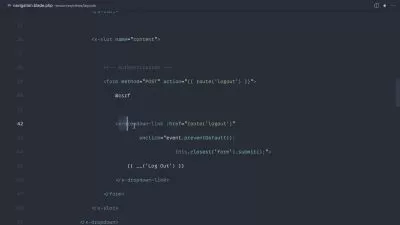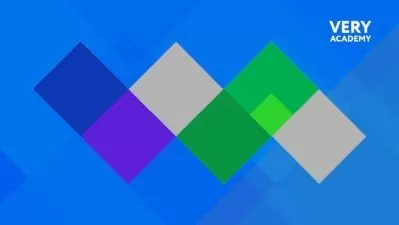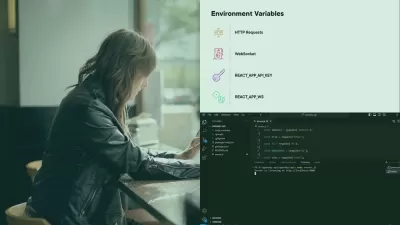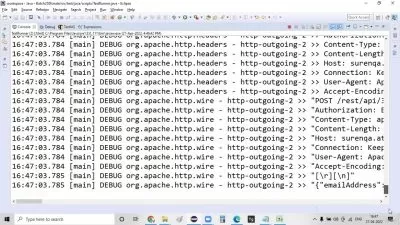Use Laravel to Consume APIs and Services Over HTTP
JuanD MeGon,ProgramarYa By JuanDMeGon
5:24:40
Description
Create an HTTP client with Laravel and Guzzle HTTP to consume any API and online service over HTTP requests from Laravel
What You'll Learn?
- Consume any HTTP service (yours or from a third party)
- Re-utilize the components created during the course to consume any HTTP service you want
- Authenticate users in your HTTP Client using information obtained from external HTTP services
- Build and HTTP Client with Laravel, completely modular and maintainable
- Domain the usage of access tokens and OAuth2 when sending requests and authorizing the requests of your HTTP Client
Who is this for?
What You Need to Know?
More details
DescriptionDo you need to consume an HTTP Service or API and it overwhelms you to think about HTTP methods, requests, OAuth2, access tokens, credentials, grant types, user sessions and so on?
I cover you! In this course, I show you that everything is about using the correct values ​​and tools to make everything much simpler.
Create your HTTP client with Laravel: Build and design a web project with Laravel, to consume online services and APIs.
Obtain data from HTTP services or APIs (yours or from third parties) and show it in a friendly and correct way to your users.
Learn step-by-step, everything you need to consume any web service or API online, with PHP from a Laravel project and using Guzzle.
At the end of the course, you will have multiple components that you can re-utilize in your projects to consume any HTTP service or API.
Do not wait any longer and sign up :)
Why should you choose this course?
Because it gives you a detailed view, as in no other course, of how to consume an HTTP service or API using Laravel and PHP.
Because it gives you the essential components that you can re-utilize in your other projects when consuming any HTTP service or API
Because you will be able and confident enough to use any service or API protected by OAuth2 and access tokens.
Because I not only show you how to create your HTTP Client with Laravel, but I also help you identify the different challenges of an HTTP Client and how to solve them properly.
Because simply, there is no other course that covers all these topics.
What will you be able to do at the end of the course?
In general, you will be able to implement an HTTP client that allows you to consume any HTTP service or API, either your own or from third parties, using PHP and Laravel. In addition, you will have a clear idea of ​​how to proceed when facing new projects and services to be consumed, reusing as much as possible the components created and learned during this course.
You will know how to use a high-level library such as Guzzle, to send HTTP requests from PHP with Laravel. Implementing generic components that allow sending requests of any kind to any HTTP service with Guzzle.
In the end, you will have gained complete confidence in sending secure and correctly authorized requests to different HTTP services, either using simple access tokens or even using an entire security mechanism such as OAuth2. Everything, using PHP and Laravel.
During the course, you will learn this...
For the HTTP Client:
How to consume a service or API through HTTP requests from Laravel
How to authenticate and create user sessions in your HTTP Client with information from other services
How to automate the process of obtaining an access token to authorize the requests of your HTTP Client
The different ways to obtain an access token from a service that uses OAuth2 and its differences (grant types)
How to handle the expiration times of a token and avoid losing access to information
How to handle access errors to the consumed HTTP service or API and how to proceed
How to handle and authenticate protected requests associated with a user's information from the HTTP Client
Use of Guzzle from Laravel, to send HTTP requests to whatever HTTP service or API
How to configure and prepare Laravel to make requests to any HTTP service or API
Use of Bootstrap 4 to show the information obtained from the consumed services
Handling and preparing to resolve exceptions and errors when consuming external services with Laravel
For any Laravel project:
How to install Laravel in your development environment for professional projects
Configure Laravel, in your environment for an agile and simple development
Build of a professional, modular and, a scalable project with Laravel
Creation of routes, views, templates, controllers and more with Laravel
Handling errors and internal exceptions of the Laravel project
Installation of dependencies to a Laravel project (Guzzle case)
Of course, that's not all. Take a look at the full description of sections and classes for more details.
It does not end there! You will have lifetime access to current classes and those I can add later to the course.
Subscribe now and do not wait any longer to consume those services that you need and obtain the information that your users require.
Still having doubts?
Do not worry, here I share some more information about HTTP Client with Laravel.
Why an HTTP Client with Laravel?
About HTTP:
HTTP (HyperText Transfer Protocol) is a widely used protocol on the Internet and any current language has a mechanism to make requests on HTTP in a simple way which, of course, includes PHP and Laravel (a framework for PHP).
Since HTTP is a protocol that is currently widely used, any current system or language will be able to communicate correctly with other systems that use this protocol (regardless of the programming language), allowing the use of data and information from whatever system online. Such information, obtained from any HTTP service, can be used in your projects to offer any type of information and service to the users of your systems. This makes you an HTTP client since you will be consuming any HTTP service or API from your own project.
About Laravel:
Laravel is the most popular framework for PHP, even one of the most popular in the world. With Laravel, you will be able to develop very complex PHP applications in a very short time, which includes an HTTP Client. During the course, you will see the enormous facilities that Laravel provides when obtaining and using the information of importance for your users, as well as facilitating the process of integrating external systems easily.
Laravel has innumerable characteristics that differentiate it from multiple frameworks for PHP and other languages, which allow implementing very complex tasks in a simple way and in a short time.
Of course, if you need more information, just get in touch :)
Subscribe now. See you in classes
Who this course is for:
- Advanced or beginners who wants to consume any HTTP service (yours or from a third party) using Laravel
- Who are having problems to domain the usage of access tokens to send and authenticate requests to HTTP services or APIs
- Who want to dominate OAuth2 and its usage to authenticate requests to protected HTTP services or APIs
- Who wants to domain the different ways to obtain valid access tokens to authorize the requests to any protected HTTP service
- Who needs to authenticate users and create sessions, using information obtained from external HTTP services or APIs
Do you need to consume an HTTP Service or API and it overwhelms you to think about HTTP methods, requests, OAuth2, access tokens, credentials, grant types, user sessions and so on?
I cover you! In this course, I show you that everything is about using the correct values ​​and tools to make everything much simpler.
Create your HTTP client with Laravel: Build and design a web project with Laravel, to consume online services and APIs.
Obtain data from HTTP services or APIs (yours or from third parties) and show it in a friendly and correct way to your users.
Learn step-by-step, everything you need to consume any web service or API online, with PHP from a Laravel project and using Guzzle.
At the end of the course, you will have multiple components that you can re-utilize in your projects to consume any HTTP service or API.
Do not wait any longer and sign up :)
Why should you choose this course?
Because it gives you a detailed view, as in no other course, of how to consume an HTTP service or API using Laravel and PHP.
Because it gives you the essential components that you can re-utilize in your other projects when consuming any HTTP service or API
Because you will be able and confident enough to use any service or API protected by OAuth2 and access tokens.
Because I not only show you how to create your HTTP Client with Laravel, but I also help you identify the different challenges of an HTTP Client and how to solve them properly.
Because simply, there is no other course that covers all these topics.
What will you be able to do at the end of the course?
In general, you will be able to implement an HTTP client that allows you to consume any HTTP service or API, either your own or from third parties, using PHP and Laravel. In addition, you will have a clear idea of ​​how to proceed when facing new projects and services to be consumed, reusing as much as possible the components created and learned during this course.
You will know how to use a high-level library such as Guzzle, to send HTTP requests from PHP with Laravel. Implementing generic components that allow sending requests of any kind to any HTTP service with Guzzle.
In the end, you will have gained complete confidence in sending secure and correctly authorized requests to different HTTP services, either using simple access tokens or even using an entire security mechanism such as OAuth2. Everything, using PHP and Laravel.
During the course, you will learn this...
For the HTTP Client:
How to consume a service or API through HTTP requests from Laravel
How to authenticate and create user sessions in your HTTP Client with information from other services
How to automate the process of obtaining an access token to authorize the requests of your HTTP Client
The different ways to obtain an access token from a service that uses OAuth2 and its differences (grant types)
How to handle the expiration times of a token and avoid losing access to information
How to handle access errors to the consumed HTTP service or API and how to proceed
How to handle and authenticate protected requests associated with a user's information from the HTTP Client
Use of Guzzle from Laravel, to send HTTP requests to whatever HTTP service or API
How to configure and prepare Laravel to make requests to any HTTP service or API
Use of Bootstrap 4 to show the information obtained from the consumed services
Handling and preparing to resolve exceptions and errors when consuming external services with Laravel
For any Laravel project:
How to install Laravel in your development environment for professional projects
Configure Laravel, in your environment for an agile and simple development
Build of a professional, modular and, a scalable project with Laravel
Creation of routes, views, templates, controllers and more with Laravel
Handling errors and internal exceptions of the Laravel project
Installation of dependencies to a Laravel project (Guzzle case)
Of course, that's not all. Take a look at the full description of sections and classes for more details.
It does not end there! You will have lifetime access to current classes and those I can add later to the course.
Subscribe now and do not wait any longer to consume those services that you need and obtain the information that your users require.
Still having doubts?
Do not worry, here I share some more information about HTTP Client with Laravel.
Why an HTTP Client with Laravel?
About HTTP:
HTTP (HyperText Transfer Protocol) is a widely used protocol on the Internet and any current language has a mechanism to make requests on HTTP in a simple way which, of course, includes PHP and Laravel (a framework for PHP).
Since HTTP is a protocol that is currently widely used, any current system or language will be able to communicate correctly with other systems that use this protocol (regardless of the programming language), allowing the use of data and information from whatever system online. Such information, obtained from any HTTP service, can be used in your projects to offer any type of information and service to the users of your systems. This makes you an HTTP client since you will be consuming any HTTP service or API from your own project.
About Laravel:
Laravel is the most popular framework for PHP, even one of the most popular in the world. With Laravel, you will be able to develop very complex PHP applications in a very short time, which includes an HTTP Client. During the course, you will see the enormous facilities that Laravel provides when obtaining and using the information of importance for your users, as well as facilitating the process of integrating external systems easily.
Laravel has innumerable characteristics that differentiate it from multiple frameworks for PHP and other languages, which allow implementing very complex tasks in a simple way and in a short time.
Of course, if you need more information, just get in touch :)
Subscribe now. See you in classes
Who this course is for:
- Advanced or beginners who wants to consume any HTTP service (yours or from a third party) using Laravel
- Who are having problems to domain the usage of access tokens to send and authenticate requests to HTTP services or APIs
- Who want to dominate OAuth2 and its usage to authenticate requests to protected HTTP services or APIs
- Who wants to domain the different ways to obtain valid access tokens to authorize the requests to any protected HTTP service
- Who needs to authenticate users and create sessions, using information obtained from external HTTP services or APIs
User Reviews
Rating
JuanD MeGon
Instructor's CoursesProgramarYa By JuanDMeGon
Instructor's Courses
Udemy
View courses Udemy- language english
- Training sessions 62
- duration 5:24:40
- English subtitles has
- Release Date 2024/04/13













